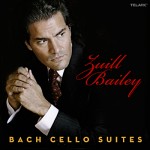Column Name
Title
Bach: Cello Suites. Zuill Bailey, cello. (Telarc 31978-02)
Body
From Juilliard alumnus Zuill Bailey (M.M. ’96, cello) comes a fresh new look at Bach’s six cello suites, collectively one of the composer’s most notable instrumental achievements. Even on a first listen, Bailey’s ability to make subtle timbral adjustments is immediately noticeable; the opening of the Third Suite combines a discreet nasal quality in the lower register, with more translucence appearing in the upper ones. Attacks have a slight burr, brimming with the overtones created by his magnificent cello—an Ex “Mischa Schneider” Matteo Gofriller instrument from 1693.
Deft bowing combines with intonation that never flags, even at high speeds. Tempos are swift, but not headlong. Bailey even manages to find some humor, such as in the dancing phrases of the Fifth Suite’s second and third movements. This suite’s famous Sarabande is done with utter confidence: those who find strength in sorrow will welcome the emotion that Bailey infuses here, and the flights into the upper registers have immaculate polish.
In some places Bailey lets a virile earthiness provide a foil for unexpected light touches, such as the in the opening movements of Suite No. 2. And check out this suite’s Courante movement (and the similarly speedy Courante in Suite No. 4), a wisp of an entry in the “How Fast Can You Play This?” sweepstakes. Bailey is not afraid to make sounds bordering on the nontraditional, letting the instrument groan slightly in pursuit of tonal variety. In all six, nothing seems taken for granted.
Despite the many classic versions of these available on disc, such as those of Casals, Fournier, and Starker—not to mention Juilliard’s own Yo-Yo Ma (Pre-College ’71, Professional Studies ’72)—this gutsy new interpretation may well stand alongside them for some listeners. Adam Abeshouse has recorded Bailey in the Academy of Arts and Letters in New York City, allowing just a whiff of the cellist’s breathing to register, which both emphasizes the superhuman effort required to play these and brings listeners right in the room.
The World Below G and Beyond: Works For Violin Subharmonics and Interactive Computer. Mari Kimura, violin. (Mutable Music 17542-2)
Since the mid-1990s, violinist Mari Kimura, a Juilliard alumna (D.M.A. ’93, violin) and member of the School’s Music Technology Center faculty, has been experimenting with phenomena known as “subharmonics.” String players create traditional harmonics by lightly resting a fingertip on the string, creating a glassy, high-pitched sound. Subharmonics, on the other hand, require a precise bowing speed and pressure to create pitches below the tuned string, and they sound earthier and scratchier. The technique Kimura has developed enables her to reach notes a full octave below the violin’s G string—without any retuning.
Opening the program is Subharmonic Partita, an homage to Bach’s E-major example, in which Kimura uses her discovery to span five octaves containing passages of staggering difficulty. These challenges reach a pinnacle in her Six Caprices for Subharmonics (1997-98), which require double-stops in which the G string is bowed to produce the subharmonics, but the D string is played normally. Another work’s title, ALT, is derived from the first letters of a comment on Kimura’s music by Mario Davidovsky, who said he had never heard “Anything Like This.” His astonished assessment could very well be applied to the entire disc.
This fascinating recording also features some of Kimura’s works for violin and computer. Vitessimo from 2007 (derived from the French word vitesse, or “speed”) and Clone Barcarolle from 2009 employ an “augmented violin” system developed at Ircam in Paris, to considerably expand the instrument’s tonal qualities. Izquierda y Derecha (“Left and Right”) uses a MIDI piano controlled by the violin to create a Nancarrow-like sonata with a Latin flavor and just a hint of Chopin’s “Revolutionary” Etude.
On Two Clos, Kimura creates a duo by overdubbing herself, improvising along with a second improvised track. Kimura ends her program with Bucknerian (2002), for voice, violin, and computer, in which singer Thomas Buckner’s voice is multiplied and processed into something resembling an unearthly, chattering choir, as the violin darts madly in and out of the mix like an equally alien hummingbird. Engineers Paul Geluso and Tom Hamilton, working at Harvestworks (in Manhattan) and Systems Two (Brooklyn) have given Kimura a pleasantly analytical soundscape, giving light and space to even the tiniest details.






